#SIKH SHASTAR
Explore tagged Tumblr posts
Photo

Sarbloh dumala kesh hair shashtar kara sikh kaur singh khalsa taksali black oo4
Sarbloh Dumala Kesh Hair Shashtar Kara SIKH Kaur Singh Khalsa Taksali Black
Design: OO4
Sarbloh (pure iron) shastars.
Beautiful hand made design.
Please see attached photos for more information. Limited stock is left.
Sarbloh shastars - Handmade design
Please do not forget to add us to your favourite sellers list and keep looking at our listings, we are going to launch a wide range of brooches and a big variety of SMART Fashions Jewellery for parties and evening wear very soon.
We are UK based supplier smartfashions.co.uk. Items can be collected from our shop in Rochester, Kent, UK. Please check 100% positive feedback received for this item.
Postage discount for multibuys.
Main Colour: Black
Main Stone: No Stone
Modified Item: No
Type: Sikh Dumala Shashtar
Gender: Unisex
Country/Region of Manufacture: India
Certification: OnlineSikhStorwe
Main Material/ Metal: Sarbloh
MPN: NO
#sikh#singh#kaur#khalsa#sarbloh#dumala#pagri#hair shashtar#kesh shastar#taksali#dumala accesories#turban
1 note
·
View note
Text
Bana - Sikh Spiritual Attire
Bana is the word for the traditional spiritual attire of a Sikh. Many Sikhs wear ceremonial bana when attending worship programs and ritual ceremonies at the gurdwara, or during holidays and festivals. Very devout Sikhs may wear bana of traditional colours every day.
Chola - Sikh Warrior Attire
A chola is the name of a particular style of bana worn traditionally by Sikh warriors. It is a kind of dress or robe which has a wide flared skirt made with panels to allow for freedom of movement. A famous story tells how Guru Har Rai, snagged his chola on a rose bush, and the lesson of self-mastery it entailed.
Hajoori
The hajoori (hazoori) neckcloth may be a narrow strip of turban cloth or other fine cloth about 2 meters or yards in length. The hajoori may be from 8 to 12 inches wide or the full width of turban cloth. It is usually white, but may occasionally be orange. The hajoori is worn by most ragis or katha performers on stage at gurwara programs. It is also worn by Nihang warriors and many Singhs or Singhis who sing kirtan. The Hajoori is also worn while reading devotional paath, preparing and serving langar or prashad. It's either wrapped or held to loosely cover the mouth.
Jutti - Footwear
Footwear is removed before entering a gurdwara worship hall. Although western styles are worn, many Sikhs still wear the traditional Punjabi style slipper known as a Jutti. These are made of leather, embellished with embroidery, and may sport a curl up toe. Initially, both slippers in a set are identical and must be worn for a while to conform to the left or right foot.
Kakar - Required Articles of Sikh Faith
The kakar are the five articles of faith:
Kachhera - Loose undergarment
Kanga - Wooden comb
Kara - Iron Bangle
Kes - Unshorn hair
Kirpan - Ceremonial short sword
An initiated Sikh is required to keep the kakar on the body at all times, day and night, regardless of circumstances.
Khanda - Embellishment of Sikh Emblem
The khanda is an emblem representing the Khalsa crest, or Sikh coat of arms. It consists of a double edge sword in the center, a circlet, and two swords. A khanda embellishment may be appliquéd, or embroidered on ceremonial Sikh clothing, or worn as a turban pin.
Kurti
Kurti is traditional casual wear worn by both men and women. Fabrics include all cotton and synthetic materials. Styles include various lengths from about mid hip to just above the knee. Sleeves can be full length, three-quarters, half sleeve, or short. Men's kurti tend to be plain white, solid colours, striped, hatched, and prints. Women's kurti range from plain white, and solid colours with contrasting embroidery often along with appliqué, to multi-colored patterns and prints
Kurta Pajama - Sikh Men's Wear
Kurta pajama is Sikh men's wear. A Kurta is a kind of long tailored shirt with side slits up to the pocket. A kurta may have a finished or straight edge cuffs and a rounded or straight hem. The pajama is a loose pant often made of fabric to match the kurta. The very devout wear simple styles in solid colours to express humility.
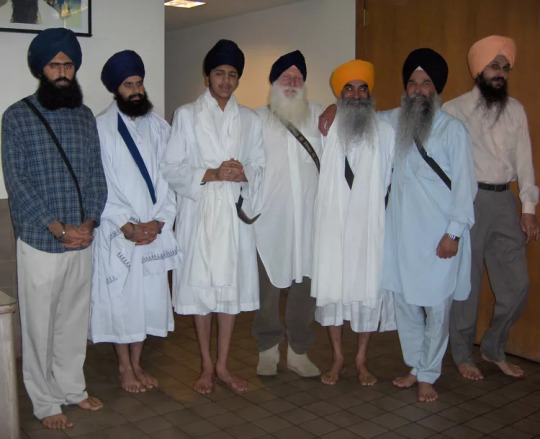
Salvar Kamees - Sikh Women's Wear
Salvar Kamees is Sikh women's wear. Salvars are baggy loose fitting pants with ankle cuffs called ponche. The salvar is worn beneath the kamees, a dress top which is available in as many styles as there is imagination, and colour, often decorated with embroidery. The color of the salvar and kamees may match or contrast. They are worn with a colour coordinated matching or contrasting chunni or dupatta. The very devout tend to wear simple prints or solid colours with a little embroidery, as an expression of humility.
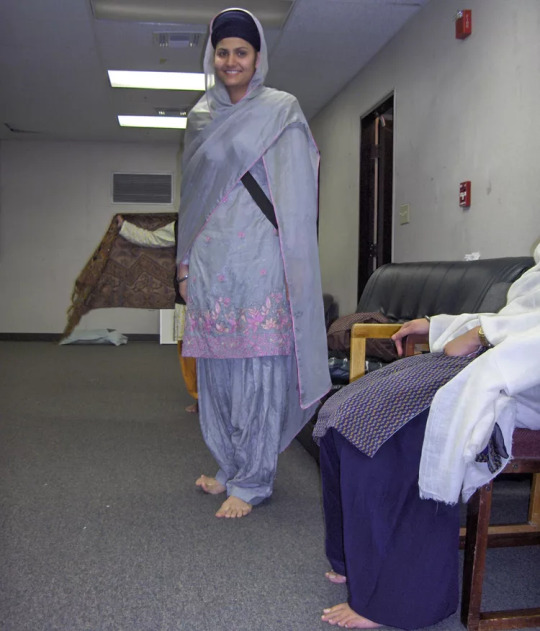
Shastar - Weaponry
In addition to the required kirpan, various types of Shastar weaponry may adorn traditional Khalsa warrior attire. Siri Sahib is a term of respect applied to a sizable kirpan. A chakar is often used to adorn a turban. A gurj is a kind of spiky mace historically used in battle and worn at the waist. A singh might also carry a teer in the form of a ceremonial spear or an arrow.
Turban - Headwear of a Sikh
The Sikh turban is worn in a variety of styles. Required wear for a Sikh man, a turban is optional for a Sikh woman who may choose instead to wear a scarf, alone, or over a turban.
Turban styles:
Domalla - Double length turban of 10 or more yards
Pagri - Double width turban of five to six yards
Dastar - A single turban of four to six yards
Keski - A short turban of two or three yards
Patka - A square of half to one yard tied over the joora (top knot) and head
Fifty - A half yard worn beneath turban
Scarf styles:
Chunni - A sheer lightweight veil of up to two and half yards
Dupatta - A double-wide fabric veil of up to two and half yards
Ramal - Square or triangular head cover
Havard referencing:
Sukhmandir Khalsa. (2018). Introduction to the Traditional Dress of Sikhs. [Online]. LearnReligion. Last Updated: 19 April 2018. Available at: https://www.learnreligions.com/traditional-dress-of-sikhs-2993014 [Accessed 18 September 2023].
0 notes
Text
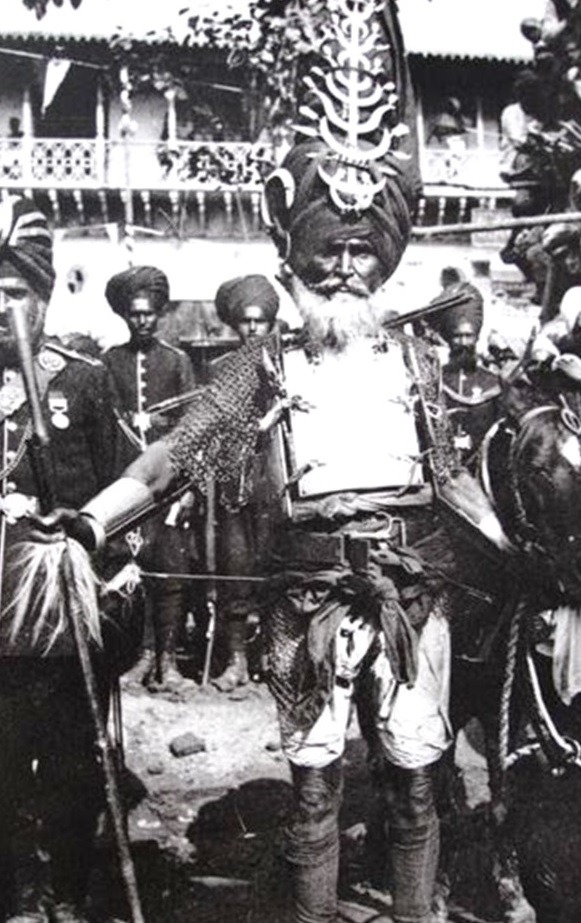
A battle-hardened Nihang Singh (traditional Sikh warrior) with a dastaar bunga (tower turban) adorning a gajga (a martial iron ornament) and traditional body armour. He seems in better shape than the younger and modern Sikh soldiers surrounding him
#Sikh#warrior#nihang#akali#vintage#britishraj#sikhempire#turban#weapons#shastars#armour#armor#shastar vidya#gatka#martial#martial arts
4 notes
·
View notes
Text
Online Sikh Store with Worldwide Shipping
Sikhstoreonline.com is leading online sikh store for Sikh Accessories and Punjabi items at best prices with worldwide shipping. Store offers a wide selection of Sikh Turbans, Gurdwara Items, Women Collection, Dumala Shastars and other sikh related materials online. We ship to all cities in Canada, USA and other countries. Shop with confidence on our 100% Secured Store.
https://sikhstoreonline.com/

1 note
·
View note
Video
tumblr
Our company name is A.E SIKHWORLD PVT LTD located at holy city Sri Amritsar Sahib. We manufactures the Sikh religious articles like KIRPANS,KARAS,KHANDAS,TEGA all handmade and we have been creating unique edged tools and weapons for enthusiasts since 1998.We are the largest manufacturer of taksali kirpans in the world.. http://aesikhworld.com
0 notes
Text




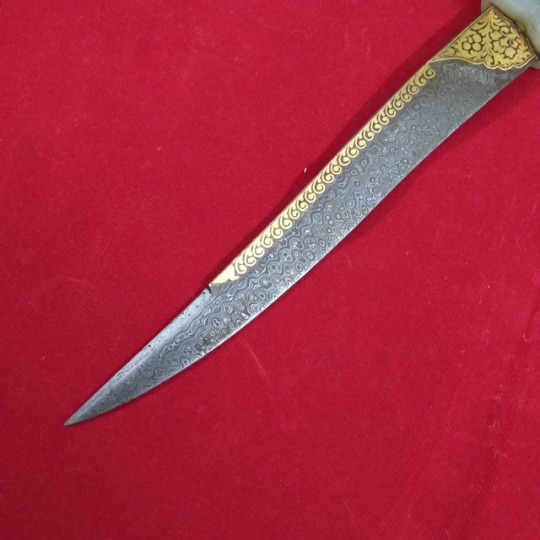

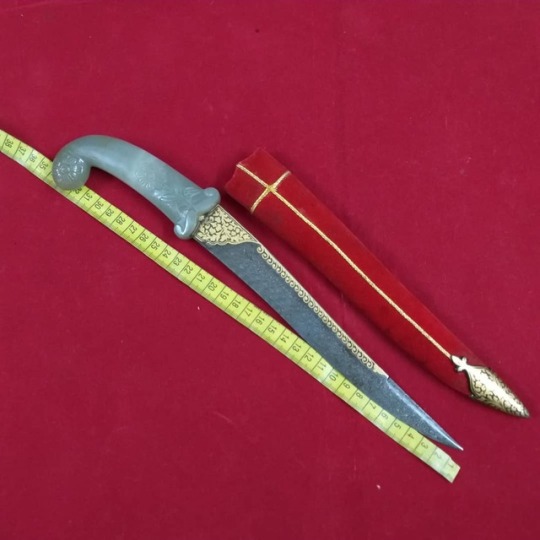


For Sell = 349$ + Shipping
New Indo Persian Mughal Ottoman Turkish Islamic Rajput Sikh Style Khanjar Or Dagger With Indian Aventurine Jade Stone Handle And Damascus Steel Blade With Gold Koftgari Or Damascening Work.
#shamshir #kilij #pala #tulwar #sword #dagger #kard #peshkabz #axe #armour #khulakhud #islamicart #spear #chakram #tegha #helmet #damascussteel #shield #knife #khanda #ottoman #khanjar #jambiya #shastar #indopersian #traditionalartdecor #wootzsteel #koftgari #indianart #artist
3 notes
·
View notes
Photo

#BhinderKalan #Kirpan #Akhar #GoldSword bhinder kalan kirpan,taksali kirpan of bhinder kalan,taksali kirpan price,taksali kirpan amritsar,sikhism,sant bhindranwale,panj kakar in sikhism,panj kakaar,panj kakar,sikh history,sikh history in punjabi,ਕਿਰਪਾਨ,sri akal takht sahib,damdami taksal,damdami taksal bhindranwale,damdami taksal jatha bhindran, ਅੱਖਰ akhar, how to make kirpan at home,how to make kirpan cover,guru gobind singh ji shastar,guru gobind singh ji shastra,sikh shastar,sikh shastar names https://www.instagram.com/p/CGMznBkhBbc/?igshid=1e8h1ejbrgnin
0 notes
Text
But when I did remember a dream...
I looked outside the window and they were all over the streets. Just arrived. On motorbikes and go karts, ready, with weapons and maybe a plan too. The road was wide like in Canada or America. The house though, was my 2nd Mammi Ji's house in Wolverhampton: it was somehow attached to a Darbar Sahib though. A programme was going on and there was Sangat to arrive later; Langar was currently being prepared. I had to tell someone. I walked fast and told some men. They knew instantly what I meant, I did not stop walking until everyone knew. I went for the men who were younger and built, we needed to protect the Sangat. My mum heard as well as the rest of the women in the room. I think I used a name for this gang "______ are here, outside. We have to do something." I don't know how I ended up in a different house. I was with the girls. I grabbed some knives from the bathroom where some work had been going on to renovate it I think. I put them in each of my cardigan pockets. I was wearing a suit and my vintage, grey, chunky knitted cardigan. I didn't take out Kirtan Ji, I didn't think it was sharp enough. I wasn't ready to fight. All the rest of the girls, like me, but not with Khalsa Roop, followed the girls who had experience. There were about 3 or 4 of them who had more knowledge of what to do. They leads us around the house and handed out weapons. Randomly, a lady in her 50s or 60s with a chunni covering her high bun and tinted glasses, short in height, lilac and pink sparkly suit, lipsticks on lips, walked in through the front door. Some girls went and helped her inside, they wore white and had plaits. Everyone was whispering: Mahapursh. I didn't understand. We watched her sit down on a white cloth in the front living room on the floor, and sip a white mug of tea. Some girls went and sat by her one by one. I went toward the stairs and my cousin was looking directly at the lady. I said "come on," in the direction of upstairs. She was fixated on the lady and said "I'm going to sit by Mahapursh for a bit." I just watched her walk away, still confused. We went upstairs and everyone was faffing around, looking outside the windows. I wasn't ready. I decided to see what was going on in the front living room (I have no idea who's house this is, no familiar layout). Not many people where there. I sat next to a lady in dark blue who sat next to the lady everyone called Mahapursh. She was sipping her tea and looked at me. I don't know if she expected me to say something, or if she already knew. Next thing you know, we're at this other front entrance to the house, which is layed out like a kitchen but with a large front door. We can see this big homemade-palki-like box, dark pink square, made out of paper or something. It was held up by white poles that some girls were holding. The girl standing inside was holding a thaal and smiling. The pink banner at the top had white, fancy writing. I cannot remember what it said but I felt like it was a congratulation message, possibly with the word "mubaarak" on it. There were about 12 girls walking with them toward us. We had the front door open and just waited for them to arrive. The door with the Mahapursh lady in was shut, not sure if locked. They came in and directly stepped into the house. I think a lot of us started Baani in our head at this point. Do we demolish them now? Do we wait? Do I follow one until I kill her? Are we in to kill? I was over thinking but I couldn't help not knowing what I needed to do and convince myself to do. Next thing you know, they're all upstairs. A few in the kitchen and garden. Fighting, or hunting each other down. I'm by the stairs. A girl is siting on the landing of the stairs with her hands through the railing of the banister, holding my cousin by her hair and cutting at it with a knife. My cousin (who's is Amritdhari but does not wear a Dastaar regularly) seemed in little pain. I didn't know at the time, but after, I realised, this was the first test from Maharaj Ji. I either tried to stab or cut the girls hands and wrists. I didn't go directly upstairs to attack her in case more girls were hiding to grab me whilst I stopped this girl. I wasn't pressing hard enough or using the knife with force. I was holding back. I panicked instantly. The next thing I did, if I did it in real life, I'd no longer be of Guru Ji's. It happened in a dream. But it reminds me. I also pulled out my hair and combed it viciously when there was a large knot that would not budge. That was in real. That was Beadbi. Would pesh fix this? Maharaj Ji know my heart regardless of pesh or not. Worthless. Guru Ji can disown me. I cut the hair. To get the girl's grip off, I cut at the hair. The girl was shocked. She thought Kes meant more to me. Sokhi couldn't even see, but she was shocked. I felt like Maharaj Ji was in my cousin all that time, watching what I would do. I ruined everything. They girl grabbed more and more hair, but I think it slipped though and I pushed Sokhi away. The girl must have ran off. I wasn't ready. I can't remember what happened next. I already failed the dream. Do not google the definition of Fake. Or open the dictionary under 'W' for weakness. Don't sit in your spelling test and wait for your teacher to say "liar" and then give you a sentence with an example. Look at me. Find me. Call me. Message me. You'll find your answer. I've had dreams like this many times. I forget about them, as with everything else, as with the fact I'm the person you should not want in your Sangat. I don't usually take dreams so seriously. But I have had similar dreams before. Sikh Youth U.K. we're in this one. They arrived with many Singh's to help demolish these gangs. Then there's me... Not leading Not fighting Not standing up Just hovering Just standing Just thinking Just hiding Just wanting Just waiting Just convincing Just being...but is it really being, if I couldn't even stand up to injustice without shouting at my mind to tell it to shut up and do Naam Simran and shut up and use your self defence and shut up and save your sisters and shut up and just go. Did you actually fear dying? Or a gash or cut? Fear doing the wrong thing? You shithead. You ended up losing Sikhi because of your stupid fears. You are a giver-upper. You are weak. You are the fakest. You are a liar. You are a hypocrite. You are a coward. You are a lamb. You are a blackened faced sinner. You are wrong. You are worthless. You are ego. You think you are. But you are not. This is a glimpse of how messed up things are inside. Why am I the worst at self defence drills but better at the practice? My mind locks itself in a cupboard called Maya and wonders around with her friends when it's needed to fight. This has to stop. This has to stop. You don't fight physically or mentally, yet you call it a battle. If you're not participating, you're not a part of any battle. You're not walking on the double edged sword, you're skipping in the dark pit, eating and eating. And all these good things that happen to bring you closer to the sword, that is Vaheguru Ji's Kirpa. I guess this is Kirpa too. Because as I thought about the dream after waking up, I had realisation. Realisation is different to wanting and believing, it is knowing. Realisation: Be ready. Train harder. Practice more. Know you can and you will. Keep Shastar. Collect Shastar. Sharpen Shastar. Look after Shastar. Pray to Shastar. Love Shastar. Be Shastar. Be ready. Tyaar Baar Tyaar comes from inside. The outside just helps you complete your task, and you complete your task with full pyaar. Everything, comes from inside. Are you ready today? 03•05•17
3 notes
·
View notes
Video
youtube
Vadhaiiyaan and mubarakaan to all my Sikh brothers and sisters on this day of Hola Mohalla! May this day further our understanding of our duty to be proactive in the midst of oppression, especially in light of current affairs. May gain knowledge of shaastar and shastar, may we be imbued in the permanent colours of Guru Sahib's Love, and may we all be able to see Hola in Anandpur Sahib at least once in our lives.
ਆਜੁ ਹਮਾਰੈ ਬਨੇ ਫਾਗ ॥ ਪ੍ਰਭ ਸੰਗੀ ਮਿਲਿ ਖੇਲਨ ਲਾਗ ॥ ਹੋਲੀ ਕੀਨੀ ਸੰਤ ਸੇਵ ॥ ਰੰਗੁ ਲਾਗਾ ਅਤਿ ਲਾਲ ਦੇਵ ॥੨॥ -ਬਸੰਤੁ ਮਹਲਾ ੫ ਘਰੁ ੧ ਦੁਤੁਕੇ
This time of year seems to follow a similar theme for many other people. Happy belated Holi to my Hindu friends, belated Purim greetings to my Jewish friends, and an early Happy Nowruz to all those who celebrate!
12 notes
·
View notes
Photo

Sarbloh dumala kesh hair shashtar kara sikh kaur singh khalsa taksali red oo3 Sarbloh Dumala Kesh Hair Shashtar Kara SIKH Kaur Singh Khalsa Taksali Red Design: OO3 Sarbloh (pure iron) shastars. Beautiful hand made design. Please see attached photos for more information. Limited stock is left. Follow us on Instagram, Facebook and Twitter #OnlineSikhStore #SikhArtefacts Sarbloh shastars - Handmade design Please do not forget to add us to your favourite sellers list and keep looking at our listings, we are going to launch a wide range of brooches and a big variety of SMART Fashions Jewellery for parties and evening wear very soon. We are UK based supplier smartfashions.co.uk. Items can be collected from our shop in Rochester, Kent, UK. Please check 100% positive feedback received for this item. Postage discount will be given for multibuys. Gender: Unisex Modified Item: No Country/Region of Manufacture: India Certification: OnlineSikhStorwe Main Material/ Metal: Sarbloh Type: Sikh Dumala Shashtar MPN: NO Main Colour: Red Main Stone: No Stone
#sikh#singh#kaur#khalsa#sarbloh#dumala#pagri#hair shashtar#kesh shastar#taksali#dumala accesories#turban
0 notes
Photo


The Guru Granth Sahib inside the South Shields gurdwara.
There are no idols, statues, or religious pictures in a Gurdwara, because Sikhs worship only God, and they regard God as having no physical form. Nor are there candles, incense, or bells, or any other ritualistic devices.The focus of attention, and the only object of reverence in the main hall (or Darbar Sahib) is the the Guru Granth Sahib, which is treated with the respect that would be given to a human Guru.The Guru Granth Sahib is kept in a room of its own during the night and carried in procession to the main hall at the start of the day's worship.
The prominence of weapons is clearly visible with a number of chakar and swords. The Sikh word for them, Shastar, contains a very different and religious meaning to the English word ‘weaponry’ which encompasses everything and has offensive insinuations. Sikhism has a martial history dating back to the time of the Sixth Guru Har Govind who armed the Sikhs following the martyrdom of his father the Fifth Guru Arjun Dev. The succeeding Gurus maintained a fighting force, but only resorted to violence when all other options were void, and they had to defend themselves in order to survive.
The Guru Granth Sahib is placed on a raised platform (Takht or Manji Sahib, meaning "throne") under a canopy (Chanani or Palki), and covered with an expensive cloth when not being read.The Gurdwara is open 24 hours a day and is managed by a committee of members, there is no central leader figure, and all members take turn in reading the scripture and leading worship. However for modern convenience now many gurdwaras now appoint a paid ‘leader’.
4 notes
·
View notes
Text
The sangat needs to be made aware of a disturbed individual who may pose same danger to other members of the community.
Harjan Singh Shubb aka Sunny Singh of Mussey Close, Marston Green, Birmingham, has been showing signs of bizarre, erratic and aggressive behaviour.
It is thought that this may have been brought on by a recent marital break up and loss of custody of his children.
Other compounding factors could be related to a background of substance abuse, mental health deterioration, or a mixture of both.
His recent posts on social media over the past few days have been very provocative. He has been making lots of racist and caste related comments and has been threatening to 'kill all Jatts'.
He has been making wild defamatory allegations against other members of the community including allegations of rape and has made open threats to kill.
He is dressed in traditional Nihang attire and is carrying numerous shastar in public including a spear and a kirpan and therefore must be considered armed and dangerous.
The sangat has been asked to remain vigilant and to avoid contact with him at all costs. The concern is that he may attack a random member of public as well as any member of the Sikh Community who questions his antics.
There are concerns that he has been evicted from his home and has been staying in a hotel room with a saroop of SGGS ji or Dasam Granth, which is clearly an inappropriate place to keep it and also a violation of maryada.
Whilst a precautionary notice to the sangat, this is also an appeal to local sikh organisations or key members to meet with the police and health authorites to ensure that he receives the help that he needs before he does something which will bring the Sikh Bana and Sikh Shastars into disrepute.
Aside from being a genuine danger, this would be a PR disaster for Sikhs in the UK media.
Please spread this message so that all members of the community can be made aware and remain safe. It is hoped that Sunny gets the help that he needs and this bizarre and wild behaviour swiftly comes to an end.
0 notes
Text
3 Age-Old Indian Techniques Of Staying Fit
New Post has been published on https://healingawerness.com/getting-healthy/getting-healthy-women/3-age-old-indian-techniques-of-staying-fit/
3 Age-Old Indian Techniques Of Staying Fit
Saumya Gaur May 9, 2019
Going by facts and figures, India is still considered as a third-world country. It is still one of the most influential and powerful nations in the world. And it’s not that this is a recent development. India had always been the cynosure of a million eyes. And we’re not saying this because we are patriotic Indians, harping about the supreme status of our country, we’re saying this because it’s a fact. You just have to browse through a few history books to realize that we are telling the truth.
One of the many reasons for which India is respected across the world is for the way it’s able to blend its rich cultural heritage with the changing trends. And this is most evident in terms of lifestyle and health. While countries across the world have just discovered the health benefits of Yoga and desi ghee, we Indians have been reaping their benefits for the better part of a century.
It’s true that old is gold, especially when it comes to fitness. So keeping this sentiment in mind, we decided to give you a low-down on three age-old Indian techniques that can help you maintain your health in peak condition. Here they are:
1. Swordsmanship And Other Indigenous Martial Arts
Source: Keralatourism
You would surely know about Bruce Lee, and if not him, then we are sure you would have heard of Jackie Chan. These personalities helped in making the defense arts of Judo and Karate popular across the world. But did you know that we have our own indigenous forms of martial arts that are just as effective as Judo and Karate?
Practicing martial arts doesn’t just make a person confident and secure, it also helps them develop a disciplined approach towards their fitness. And this principle was utilized by ancient Indian society, where people practiced swordsmanship and other martial arts not only to stay agile but also to stay healthy and fit.
If you too are keen on scoring this two-in-one benefit of practicing martial arts, you can try and learn any of these martial arts-
Kalaripayattu: An ancient martial art form developed in Kerala which is focussed on harmonizing the connection between body and mind.
Thang Ta: Martial art form developed in Manipur which uses a lot of weapons, including swords. It integrates soft moving patterns and coordinates them with one’s breathing.
Silambam: Developed in Tamil Nadu, it is one of the oldest martial arts in the world. It employs a lot of footwork to focus on fluid fighting moves.
Gatka/ Shastar Vidya: Gatka is a toned-down version of Shastar Vidya, a fearsome fighting technique evolved by Sikh warriors. In gatka, the swords of Shastar Vidya are replaced by wooden sticks and shields.
Sqay: An ancient martial art that originated in Kashmir, this martial art’s unarmed form relies heavily on punches, locks, and chops.
Kushti: A traditional wrestling sport that was developed during the Mughal era, and is still practiced across the country.
2. Dancing
Source: Keralatourism
While you have been sweating it out to the beats of Zumba, you should also consider the traditional forms of dance that are practiced in our country for your fitness needs. India is home to 8 classical dances which are renowned all over the world for their unique storytelling techniques and intricate structure. Almost all of these dances rely heavily on the skills of dexterity and agility. And practicing them regularly would not just be a great way to work out, but it will also allow you to partake in the cultural heritage of your nation, something that you can proudly claim as yours. If you want to give dancing a chance, you can try any of these classical dances-
Bharatnatyam: Its state of origin is Tamil Nadu, and it’s a pretty demanding dance form.
Kathakali: This is a religious dance that originated in the state of Kerala. It was traditionally performed by only men and boys.
Mohiniattam: Another performing dance art form that originated in the state of Kerala.
Kuchipudi: A dance form that originated in the state of Andhra Pradesh, which relies heavily on gestures and hand movements or mudras.
Manipuri: This dance form that originated in Manipur, employs rhythmic movements and gentle footwork. It can provide one an ideal amount of exercise.
Odissi: From the state of Orissa. It employs fast-paced, athletic, and acrobatic moves.
Kathak: It originated in the state of Uttar Pradesh. This dance form makes use of rigorous footwork.
Satriya: A dance form from the state of Assam, it employs intricate footwork and mudras in its core structure.
Apart from these, you could also learn the other indigenous dances called folk dances which aren’t thought of as high art, but they are just as good for developing a disciplined fitness regimen.
3. Yoga
Shutterstock
Much before our dear Prime Minister mandated it to be celebrated and glorified, Yoga or yog was a part and parcel of the Indian way of life. Unlike most athletic and fast-paced forms of exercises, Yoga concentrates on making one’s body more flexible and establishing a harmonious connection between the mind and the body with gentle breathing patterns and intricate poses.
And the great thing is that it doesn’t demand any prior knowledge or expertise. Anyone can practice Yoga moves. Practicing Yoga will benefit not only your body but your mind too!
So the next time you think about getting on the fitness wagon, consider trying these ancient and time-tested techniques. You might be surprised to see the results!
Are you aware of any other ancient fitness techniques? If you are, please share them with us in the comments.
The following two tabs change content below.
Latest posts by Saumya Gaur (see all)
Saumya Gaur
RELATED ARTICLES
Source: https://www.stylecraze.com/trending/age-old-indian-techniques-of-staying-fit/
0 notes
Photo

Our company name is A.E SIKHWORLD PVT LTD located at holy city Sri Amritsar Sahib. We manufactures the Sikh religious articles like KIRPANS,KARAS,KHANDAS,TEGA all handmade and we have been creating unique edged tools and weapons for enthusiasts since 1998. http://aesikhworld.com/
0 notes
Photo

New Indo Persian Mughal Maratha Rajput Sikh Decorative Wedding Swords Tulwars With Damascus Steel Blade And Silver Koftgari Hilt & Parts. #shamshir #gold #traditionalartdecor #tulwar #sword #dagger #kard #peshkabz #axe #armour #mughalart #mughalarms #spear #auction #tegha #hinduarms #vintage #orientalarms #armsandarmours #antique #damascussteel #khanjar #jambiya #shastar #mughal #nihang #sikh #koftgari #indianart #indianartist (at Koftgari Art) https://www.instagram.com/p/Bo0pnSdhC35/?utm_source=ig_tumblr_share&igshid=dljvwsdjczf0
#shamshir#gold#traditionalartdecor#tulwar#sword#dagger#kard#peshkabz#axe#armour#mughalart#mughalarms#spear#auction#tegha#hinduarms#vintage#orientalarms#armsandarmours#antique#damascussteel#khanjar#jambiya#shastar#mughal#nihang#sikh#koftgari#indianart#indianartist
0 notes
Photo
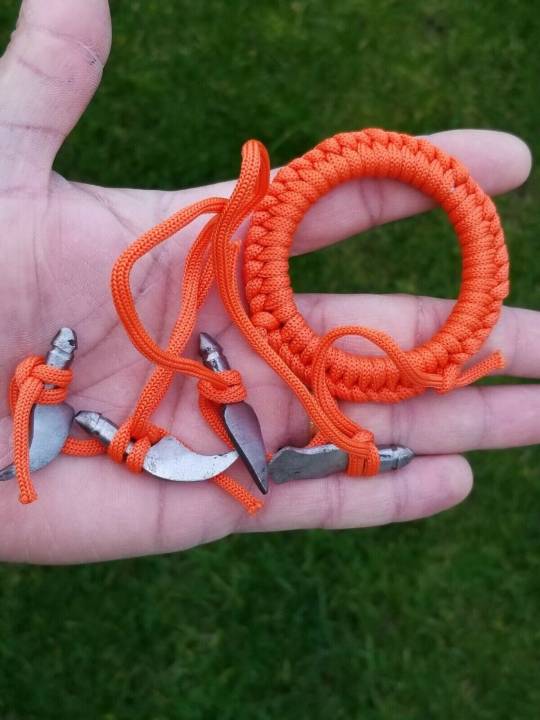
Sarbloh dumala kesh hair shashtar kara sikh kaur singh khalsa taksali orange oo1 Sarbloh Dumala Kesh Hair Shashtar Kara SIKH Kaur Singh Khalsa Taksali Orange Design: OO1 Sarbloh (pure iron) shastars. Beautiful hand made design. Please see attached photos for more information. Limited stock is left. Follow us on Instagram, Facebook and Twitter #OnlineSikhStore #SikhArtefacts Sarbloh shastars - Handmade design Please do not forget to add us to your favourite sellers list and keep looking at our listings, we are going to launch a wide range of brooches and a big variety of SMART Fashions Jewellery for parties and evening wear very soon. We are UK based supplier smartfashions.co.uk. Items can be collected from our shop in Rochester, Kent, UK. Please check 100% positive feedback received for this item. Postage discount will be given for multibuys. Gender: Unisex Modified Item: No Country/Region of Manufacture: India Certification: OnlineSikhStorwe Main Material/ Metal: Sarbloh Type: Sikh Dumala Shashtar MPN: NO Main Colour: Orange Main Stone: No Stone
#sikh#singh#kaur#khalsa#sarbloh#dumala#pagri#hair shashtar#kesh shastar#taksali#dumala accesories#turban
0 notes